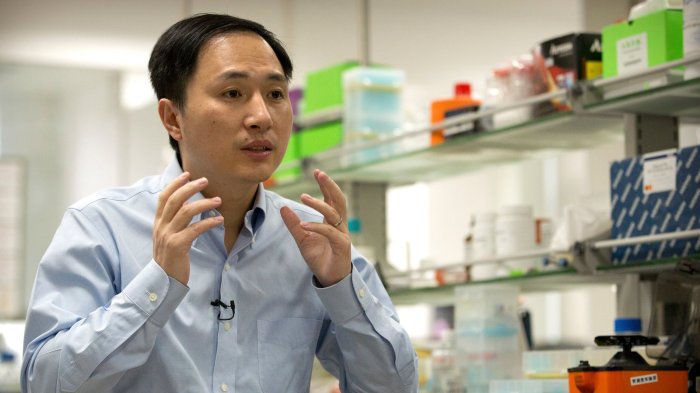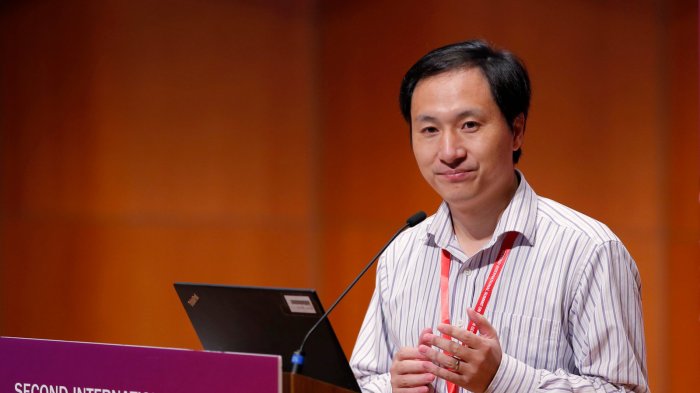Scientific Breakthrough and Ethical Implications
The news of Chinese scientists developing the first genetically edited human embryos sent shockwaves through the scientific community and beyond. This groundbreaking achievement, while potentially revolutionary, also raises profound ethical questions about the future of human evolution.
The ability to alter the genetic makeup of human embryos opens up unprecedented possibilities for treating inherited diseases. By correcting faulty genes, scientists could potentially prevent the transmission of debilitating conditions like cystic fibrosis, Huntington’s disease, and muscular dystrophy. This could lead to a future where these diseases are no longer a threat to future generations.
Ethical Considerations of Editing the Human Germline
Editing the human germline, the genetic material passed down from parents to offspring, presents a unique set of ethical challenges. Unlike gene therapy, which targets specific cells in the body, germline editing permanently alters the genetic code, potentially impacting future generations.
- One major concern is the potential for unintended consequences. The complex interplay of genes makes it difficult to predict how editing one gene might affect other aspects of development. Unforeseen side effects could arise, potentially leading to unforeseen health problems in future generations.
- Another ethical concern is the potential for “designer babies.” The ability to edit genes raises the possibility of parents selecting traits like eye color, height, or intelligence in their children. This could lead to a society where genetic enhancements become a privilege, exacerbating existing inequalities.
Comparison with Gene Therapy
While germline editing shares some similarities with gene therapy, it also presents distinct ethical challenges. Gene therapy targets specific cells in the body, with the effects limited to the individual being treated. In contrast, germline editing affects all cells in the body and can be passed down to future generations.
“The difference between gene therapy and germline editing is like the difference between fixing a broken window and changing the blueprints of the house.”
This distinction highlights the greater potential for unintended consequences and ethical dilemmas associated with germline editing.
The CRISPR-Cas9 Technology
The CRISPR-Cas9 system, a revolutionary gene editing tool, played a central role in the Chinese scientists’ experiment. This technology, derived from the bacterial immune system, allows researchers to precisely modify DNA sequences with remarkable efficiency.
Mechanism of CRISPR-Cas9 Gene Editing
The CRISPR-Cas9 system functions like a molecular scalpel, targeting specific DNA sequences for editing. It comprises two key components:
- Cas9 enzyme: This enzyme acts as a molecular scissor, cutting the DNA at the targeted site.
- Guide RNA (gRNA): This RNA molecule serves as a guide, directing the Cas9 enzyme to the precise location in the genome. The gRNA contains a sequence that complements the target DNA, ensuring the Cas9 enzyme cuts the DNA at the correct location.
Once the DNA is cut, the cell’s natural repair mechanisms can be harnessed to introduce desired changes. These changes can include:
- Insertions: Adding new genetic material to the DNA sequence.
- Deletions: Removing specific segments of DNA.
- Modifications: Altering existing DNA sequences.
Genes Targeted in the Chinese Scientists’ Experiment
The Chinese scientists targeted the gene responsible for the CCR5 protein, a receptor on the surface of immune cells that HIV uses to enter and infect cells. The intended effect of the edit was to introduce a mutation that would make the CCR5 gene non-functional, rendering the cells resistant to HIV infection. This mutation, known as the “delta 32” mutation, occurs naturally in some individuals and confers HIV resistance.
Delivery of CRISPR-Cas9 System into Human Embryos
The CRISPR-Cas9 system was delivered into the human embryos using a method called microinjection. In this technique, a fine needle is used to inject the Cas9 enzyme and gRNA directly into the fertilized egg. This method ensures that the CRISPR-Cas9 system is present in the embryo’s cells from the very beginning of development.
Key Features of CRISPR-Cas9 Technology
| Feature | Description |
|---|---|
| Advantages |
|
| Limitations |
|
Global Response and Regulatory Landscape
The news of the first genetically edited human embryo sent shockwaves through the international scientific community, sparking a heated debate about the ethical implications and the future of gene editing technology. The experiment, while a groundbreaking achievement, raised serious concerns about the potential for unintended consequences and the slippery slope towards designer babies.
International Reactions
The scientific community responded with a mixture of excitement, caution, and concern. While some scientists hailed the breakthrough as a major step forward in understanding human development and potential treatments for genetic diseases, others expressed deep ethical concerns. The potential for off-target effects, the risk of creating unintended mutations, and the possibility of creating a genetic divide between those who can afford gene editing and those who cannot were all cited as major concerns.
Key Regulatory Bodies and Their Stances
Several international regulatory bodies play a crucial role in overseeing gene editing research.
- The World Health Organization (WHO) has established a framework for responsible governance of human genome editing, emphasizing the need for transparency, ethical oversight, and public engagement.
- The United States National Institutes of Health (NIH) has a strict policy prohibiting the use of federal funds for research involving gene editing of human embryos that could be implanted.
- The European Union has implemented regulations that prohibit the use of gene editing for germline modifications, emphasizing the need for further research and ethical considerations.
- The Chinese government, while initially supportive of gene editing research, has taken a more cautious approach in recent years, calling for stricter ethical guidelines and regulatory oversight.
Impact on Existing Regulations and Guidelines
This research has prompted a reevaluation of existing regulations and guidelines for gene editing research. Several countries have begun to review their policies and consider stricter regulations for human germline editing. The debate has also highlighted the need for clear ethical frameworks and international collaboration to ensure responsible development and use of this powerful technology.
Comparison of Regulatory Frameworks, Chinese scientists develop first genetically edited human embryo
The regulatory frameworks for gene editing research vary significantly across different countries. Some countries, like the United States, have strict regulations that prohibit germline editing, while others, like China, have taken a more permissive approach. This disparity in regulatory frameworks has raised concerns about the potential for “gene editing tourism” and the need for international cooperation to ensure responsible and ethical use of this technology.
Future Directions and Research Applications: Chinese Scientists Develop First Genetically Edited Human Embryo
The groundbreaking development of genetically edited human embryos opens a new chapter in scientific exploration, promising transformative applications in various fields. While the ethical implications of this technology are still being debated, its potential for addressing genetic diseases, enhancing human capabilities, and advancing scientific understanding is undeniable. This section delves into the potential applications beyond treating genetic diseases, outlining a research plan for further investigating the safety and efficacy of gene editing in human embryos, and exploring its impact on various sectors.
Potential Applications Beyond Treating Genetic Diseases
The CRISPR-Cas9 technology has the potential to revolutionize medicine, agriculture, and environmental science beyond its initial focus on treating genetic diseases. Its ability to precisely modify DNA sequences opens up a vast array of possibilities.
- Enhanced Disease Resistance in Crops: Gene editing can be used to introduce traits into crops that make them resistant to diseases, pests, and harsh environmental conditions. This can lead to increased crop yields, reduced reliance on pesticides, and improved food security.
- Tailored Therapies for Complex Diseases: CRISPR-Cas9 can be used to develop personalized therapies for complex diseases like cancer, by targeting specific mutations in cancer cells and inhibiting their growth.
- Organ Regeneration: Gene editing could be used to reprogram cells to regenerate damaged organs, potentially revolutionizing organ transplantation and treatment of organ failure.
- Enhanced Human Capabilities: While ethically controversial, gene editing could potentially be used to enhance human capabilities like muscle strength, cognitive function, or disease resistance.
- Conservation and Biodiversity: CRISPR-Cas9 can be used to modify genes in endangered species to enhance their survival and resilience in the face of environmental threats.
Research Plan for Investigating the Safety and Efficacy of Gene Editing in Human Embryos
Given the potential risks and ethical concerns associated with gene editing in human embryos, rigorous research is crucial to ensure its safety and efficacy. A comprehensive research plan should include the following:
- In-depth Preclinical Studies: Extensive animal studies are necessary to assess the long-term safety and efficacy of gene editing in model organisms, including potential off-target effects and unintended consequences.
- Development of Robust Safety Measures: Rigorous quality control measures should be implemented to ensure the accuracy and specificity of gene editing techniques, minimizing the risk of unintended mutations.
- Long-Term Monitoring of Edited Embryos: Long-term follow-up studies are essential to monitor the health and development of individuals born from genetically edited embryos, assessing potential risks and benefits over time.
- Ethical Oversight and Public Engagement: Open and transparent discussions with the scientific community, policymakers, and the public are crucial to address ethical concerns and establish clear guidelines for responsible gene editing research.
Potential Future Applications of CRISPR-Cas9 Technology
The CRISPR-Cas9 technology holds immense promise for revolutionizing various fields, from agriculture and medicine to environmental science. Here’s a table outlining potential applications across different sectors:
| Field | Potential Applications |
|---|---|
| Agriculture |
|
| Medicine |
|
| Environmental Science |
|
Impact on the Future of Human Health and Society
The CRISPR-Cas9 technology has the potential to significantly impact the future of human health and society. It could lead to the eradication of genetic diseases, the development of personalized medicine, and the creation of more resilient crops and ecosystems. However, it is crucial to proceed with caution, addressing ethical concerns, and ensuring responsible development and application of this powerful technology.
Chinese scientists develop first genetically edited human embryo – The Chinese scientists’ experiment has opened a Pandora’s Box of possibilities and perils. While the potential to cure genetic diseases is undeniable, the ethical concerns surrounding gene editing are equally weighty. This research has forced us to grapple with the profound implications of manipulating the human germline, prompting a global conversation about the boundaries of scientific progress and the future of human evolution. As we stand at this pivotal moment, we must proceed with caution, guided by ethical principles and a deep respect for the sanctity of life. The future of gene editing remains uncertain, but one thing is clear: this technology has the power to reshape the world, and how we navigate its potential will determine the course of humanity for generations to come.
The news of Chinese scientists creating the first genetically edited human embryo sent shockwaves through the scientific community, raising ethical concerns about the potential for designer babies. While the implications of such a breakthrough are still being debated, it’s interesting to note that even in the world of finance, algorithms are being used to identify potential risks. JPMorgan has an algorithm that helps identify rogue bankers , highlighting the growing reliance on technology to mitigate risks in various fields.
The future of genetic engineering, much like the future of finance, seems to be increasingly intertwined with the development of sophisticated algorithms.
 Standi Techno News
Standi Techno News

